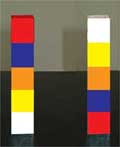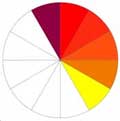Color Theory – What is it?
Color theory is complex, there are so many parts to learning about color that people often give up and employ an expert.
Don’t despair, we have broken down color into bite size pieces for you to digest.
Learn a little at a time, practice using this color information and you will soon start to appreciate the value of using color in your home.
Some people have a natural ability to “see” color and visualize what it will look like when applied, others will struggle for weeks just selecting a color for carpet, or a window trim.
Whatever your ability, using this web site will help you speed up your color making decisions through giving you simple but concise color theory and advice.
Breaking down the complex barriers of color theory.
You can learn about anything if you simplify the process. We have done that with color theory and have made small articles on the theory of color so that you can learn and take advice from each area. This way you focus on one color topic at a time and find out how it works.
Color is a fantastic way to introduce your personality to your interior decorating, so read on to understand more about color, this way you will gain confidence to express your own personality into your home decor with color.

The Colors of Light and the Color Spectrum
Through Isaac Newton’s fascination with the behavior of sunlight passing through a prism, we can today understand the colors of light.

Color Psychology – Color Appearance of Size
Color changes the apparent size of objects. The colors that look heavy also look small.

Psychological Effects of Color in Interior Design
We understand about warm and cool colors and how they affect our health and bodies, but they can also affect our behavior.
Psychology of Color – Color Weight
It is interesting to look at color as having a weight. Red seems to appear the heaviest, followed by orange, blue and …..

Primary, Secondary and Tertiary Colors
The scientist and naturalist Moses Harris created the first color wheel to classify red, blue and yellow as the three primary colors.

Cultural Color
Generally, our history and family background give us our initial associations with color.

Munsell Color System
The American Artist Albert Henry Munsell published a system in which he proposed a five pigment primary system, the principal hues using green, blue, purple, red and yellow.

Warm and Cool Colors
The reds, yellows and oranges of the color wheel are referred to as the warm colors.

Spiritual Color
The color of the aura that they see is thought to give off the person’s state of spirituality and health.

Environmental Color Responses
Red to all of us, who drive cars on the road, is associated with stop – stop signs and traffic lights or signals…
Find More Knowledge on Color
Popular Color Schemes
Free Color Course
Color Articles
Color Information
Color Meanings
Color Schemes
Color Theory
Paint
